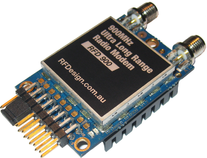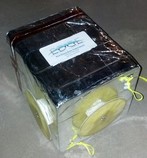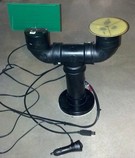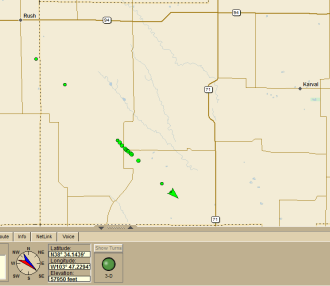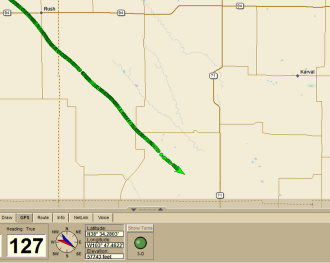RFDesign RFD900 Radio Test
On May 25, 2012, a member of DIY Drones (screen name: Seppo) posted the following:
Hi All,
I would like to introduce you to a new radio modem that we developed for very long range datalinks!
http://rfdesign.com.au/RFD900.php
Because of the nature of the research that we are working on, a high-reliability long-range radio solution is always interesting to us; we got in touch with Seppo, asked if anyone had used his radios on a high-altitude balloon, and he sent out a pair of radios for us to test. We particularly wanted to test these radios, as they're smaller and less expensive than the 9xTends that we've relied on for years (even prior to our work with EDGE), function off of an open-source codebase, and seemed to be designed to ensure the reliability of the RF link and avoid interference with other equipment. Some of the features that particularly caught our attention on these modules included:
- Integrated passive band-pass Tx filter
- Much more configurable RF symbol rates (as compared to the 9xTend)
- Built in Tx and Rx diversity
The Bottom Line
These radios absolutely rock. If you want details on the testing and the results, read on, but if you're just looking for an answer, that's it. For point-to-point, long-distance, high-reliability communications, we haven't seen any better hardware. The few (very small) issues that we found are software-based, and that's open source; in the RF world you have to get the hardware right or nothing else matters, and Seppo and his team have definitely gotten the hardware right.
The Payload
Because we wanted to test the functionality of the RFD900 head-to-head with the xTend radios, the payload was simple: just a GPS unit attached to the data input of both radios. The RFD900 payload enclosure is shown at right, with the pair of circularly polarized 900MHz antennas used attached to the enclosure. These antennas are available through Kent Electronics, and are a fantastic low-cost, low-weight antenna solution. They tend to be harmonic rich, though, and will desense GPS units when paired with the xTend radios without a bandpass (or lowpass) filter. The fact that we could use them without external filters is a testament to the effectiveness of the Tx bandpass filters and the signal shaping done by the RFD900. With the addition of a 2250mAH LiPoly battery, a regulator, and the wiring harness, the total weight for this payload came out to just under 1 pound.
The Mobile System
The plan for testing called for an xTend mobile unit on one chase vehicle, and the RFD900 mobile unit on another chase vehicle, with the two chase vehicles sticking together. The RFD900 mobile unit is shown at left, on its 6" mag mount (which held it securely through highway speeds of 75mph, oriented with the circularly polarized antenna leading). The use of a circularly polarized antenna and a 6dBi linear yagi enabled the RFD900 to take advantage of its built-in diversity and also take advantage of the fact that, when viewed edge-on, the payload antennas appear to be linearly polarized. Because the RFD900s require bi-directional communication, a 12V mobile plug was added to the system, in addition to the USB connection. (The xTend chase unit consisted of a single 6dBi PCB yagi on a similar mag mount, and only required a USB cable.)
The Results
The results speak for themselves; check out the images below. First is a sample of the received data from the 9xTend, followed by the same snippet as received by the RFD900. Both chase teams were at Limon, CO (approx. 40 miles away from the spot directly under the balloon) for the period of the flight represented by this section of map. When you factor in the altitude (approx. 60,000 feet), the line-of sight distance is 41.58 miles, or 67 km. While we have seen (and did see on this flight) longer distance communications using the xTends, this test was a test of link reliability; at this point, both chase vehicles were in exactly the same place, and did not experience identical reliability. The RFD900s showed no signs of slowing down, with nearly 100% of packets received giving every indication that they could keep going for a lot further than we gave them the opportunity to.
Technical Details
Some specifics on the configuration and capabilities of both radios follow. Note that the one substantial drawback to the RFD900 (it only supports point-to-point connections) is currently being explored in software by a number of people. Once the RFD900 can handle point-to-multipoint or (preferably) mesh topologies, it will be the go-to radio for long-haul telemetry communications.
| RFD900 | 9xTend | |
| Power Consumption (avg, as config'd) | 281mA | 169mA |
| RF Symbol Rate (as config'd) | 16k/Sec | 9.6k/Sec |
| Transmit Power | 30dBm | 30dBm |
| Point-to-multipoint / mesh networking | No | Yes |
| Integrated Tx bandpass filter | Yes | No |
| Built-in diversity | Yes | No |

